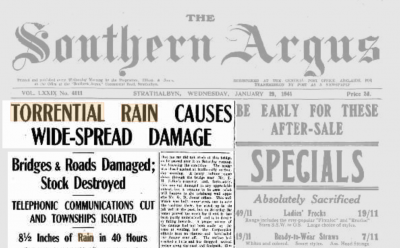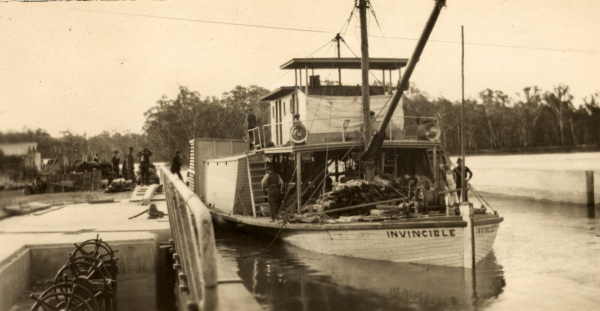Floods in Goolwa in February 1941

February 1941 -
Goolwa goes to war again 1939 – 1945
Over a week of heavy storms in the last week of January has brought over 12 inches of rain to the nearby hills and continued to inundate the whole district up until the 2nd of this month when wild windy weather from the tropical depression dump over six inches of rain in and around Goolwa. In the town there were several houses which have suffered roof damage, while the wild storms have inflicted major damage to the local fishing fleet. As the stormy winds and rain passed, the sun broke through and fishermen and other residents went about the work of recovering the severely crippled fishing fleet strewn about their anchorages.

After checking over the storm battered fleet it has been found that 11 vessels had sunk at their anchorages and at present crews of men are battling to keep them afloat while others carried out temporary repairs. Not so lucky are 4 other boats raised by the men and pulled to shore. These had suffered frame and hull damage and may be written off as wrecks. Charlie Godfrey’s “Mountaineer” and Ernie Godfrey’s “Invincible” were big boats with serious hull damage while Martin Yerve’s “Federal” and Colin Treleaven’s boat suffered twisted frames and fractured ribbing causing hull planks to spring loose.
Bert Armfield began to take some of the bigger boats onto his slip and Atkin’s slip on Liverpool Road is looking busy with many tradesmen and others working at both slips. Fortunately, the stormy weather passed away as quickly as it started, bringing a return to a couple of days of steamy heat. For the surviving fleet, including some of those carrying patched up damage, it was a race to pass through the barrage into the Murray Mouth saltwater channels and down the Coorong as the Mulloway run had started in a big way. In this first run it is estimated that around 18 tons of fish had gone from Goolwa and split between the Adelaide and Melbourne markets. Thanks to the work being done to avoid overloading the Adelaide market, the steering committee for the proposed district fishermen’s association had worked out the interstate marketing strategy although not new, as one of several ideas to overcome market flooding.
2/3rd Machine Gun Regiment regulars’ marches into Goolwa
The wind and rain storms of last week have passed, so on Thursday morning of the 6th, a fine and warm late summer day, great relief from the steamy days following that big storm helped bring out a large assembly of locals to gather in groups alongside Cadell Street to witness the entry of some 700 soldiers, led by their C.O., Lt. Colonel Arthur Blackburn VC., of the 2/3rd Machine Gun 1Regiment, as they marched into Goolwa. The first group to greet them at their town entry from Currency Creek were the enthusiastically cheering children of the primary school, a greeting which was evidently much appreciated by the soldiers who returned the children’s excited welcome with big smiling faces.
Further along the street the welcome continued by flag waving and vocally active groups until they reached the Soldiers Memorial Garden. At this point they halted and were dismissed to the lawns of the garden for a mess-break midday meal. During this 12-day 200-mile return route march from Woodside camp, the army was supported by a newly designed advanced catering unit known as the Wile’s mobile kitchen, a brilliant piece of Aussie engineering which can turn out hot meals and drinks on a large scale within a few minutes after being set up. Lt. Colonel Blackburn had been field testing the unit with his troops since 1939. The troops were given a short free time while preparations for mess arrangements were put in place which allowed them a quick visit to either the nearby Corio or Goolwa Hotel for a beer.
After the midday meal the regiment reassembled into their column to set off on a short march via Barrage Road to their overnight campsite on 2Alyffe’s farm. Here they carried out the various camp duties and went on parade for instruction and dismissal. At this time, members of the Goolwa Fighting Forces Comfort Fund group visited the men in camp to distribute comfort packages to them. The ladies were proud of their efforts in giving gifts made up from a total of 970 cigarettes, 5 cases of oranges and 12 dozen packets of Wrigley’s chewing gum which the men gratefully appreciated.
Following evening mess, the regiment responded to an invitation to a dance in the Goolwa Institute hall arranged by the combined patriotic groups in the town. Next morning, they broke camp to cross the sand hills to assemble in columns for a march along Goolwa Beach to Middleton, there to regain the main road and head to their next stop-over for two days at Victor Harbor.
Part-time military service begins at Goolwa
Compulsory Universal Military Service trainee enrolments are now in full swing showing that approximately 400 young men between the ages of 19 and 33 in the local area have registered for enrolment under the government’s scheme. Medical examination of men between the ages of 20 and 28 are to begin throughout the district starting at the Victor Harbor town hall the first week of March, then progressively visiting Goolwa, Milang and other centres.
Two more Goolwa men joined up in the 2/AIF in February. Max (M.D.) Byrnes, farmer of Verco Terrace and Col (C.F.) Smith, fisherman of Loveday Street added to the growing number of enlistees heading off into the armed services.
Fighting a crumbling Italian army in North Africa
In Egypt, the 2/10th battalion in which the Goolwa men serve in the 18th Brigade, have now been posted from the 9th to the 7th Division and will soon be moved into a holding position at Tobruk. Their desert fighting training is now completed ready for the 18th Brigade’s specific role in taking Italian positions as they were by-passed by the main force heading west along the Libyan coastline in the Operation Compass campaign. This main force clashed with the retreating Italian 10th Army on February 7 during the Battle of Beda Fomm and after several days of desperate fighting in and south of Benghazi, the British force accepted the surrender of around 130,000 Italian troops.
Churchill visits the United States
Churchill had discussions with US President Roosevelt last December about the enormous financial burden of fighting the war being carried by Britain alone was becoming unsustainable and could not be carried effectively beyond year’s end without extensive credit. President Roosevelt has responded by inviting P.M. Churchill to the US for discussions on the situation. Congress had passed in 1934 the Johnson Debt-Default Act preventing sales of arms to warring nations on credit. Roosevelt proposed an alternative to Congress which would provide a lend-lease arrangement whereby war material could be provided on loan to Britain and “returned” at the end of the war. This month an Act to that effect had been passed in the House of Representatives on February 8 and sent up to the Senate for debate.
Churchill was not going to take chances of it being rejected by leaving it in the hands of the senators without boosting his case personally, so he took the opportunity to address Congress at their invitation on the 9th. Surrounded by the microphones of the national broadcasters, he made his case to the American nation and their representatives. It was a significant speech which he ended with a compelling statement he thought would stir their senses to respond.
“Put your confidence in us. Give us your faith and your blessing, and under Providence all will be well. We shall not fail or falter; we shall not weaken or tire. Neither the sudden shock of battle nor long-drawn trials of vigilance and exertion will wear us down. Give us the tools and we will finish the job”.
Churchill’s presence and the power of his words were effective, and The Lend-Lease Act was passed in Congress to be sent to President Roosevelt to be signed into law.
German forces arrive in Tripoli
Hitler, under the Axis Triparty agreement has been forced to support the crumbling Italian army in North Africa. He has sent one of his top generals, Irwin Rommel, to command a force to be known as the Afrika Corps to halt and turn back the successful British Operation Compass campaign. The elements of this force arrived in Tripoli on the 11th February. It would not be long before the 18th Brigade, 2/10th Battalion Goolwa men amongst others, would meet this new enemy force in battle.
Foot Notes
1 The 2/3rd Machine Gun Battalion was formed in SA at Wayville on 17th June 1940, with Lt. Colonel Arthur Blackburn VC as its commanding officer. Four such units were raised within the part-time militia by converting the Light Horse to motorised units. Although designated an S.A. battalion, personnel were recruited from several states, but South Australians predominated through the ranks.